- The University of Alabama Libraries
- Libraries
- Special Collections
- Research Portals
- Slavery, Abolition and Emancipation
- Archival Sources
Archival Sources
Researching the Artifacts and Evidence of Slavery
Beyond published materials, preserved first-hand accounts of slavery from the point of view of the enslaved are few and far between. Our archival collections, though largely limited to the documentary byproducts of slavery created by the slaveowners, contain a wide variety of materials that help enrich our understanding of the institution and its effects. They include personal papers (diaries, letters), materials related to plantation farming (ledgers, receipts), and artifacts of everyday life during the period (other documents and ephemera). Photographs are rare: photography was still in its infancy and was not often used to capture images of enslaved people.
Archival materials generated by freed people and those born in the generation after emancipation can also be difficult to find.
Note: Some collections appear in multiple sections; the larger they are, the more likely they cover multiple areas of interest, and they have been included in all appropriate lists. In the case of these larger collections, the box and folder with materials pertinent to that section have been given.
You can search for unpublished materials held by Special Collections in our Archival Collections database. Some of this can also be found through our Digital Collections, which contains digitized materials as well as all available Finding Aids, even for collections which have not been digitized.
By Record Type
1. Church Records
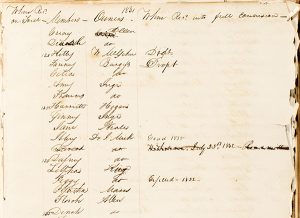
Includes church registers and notes on activities, generally with African Americans included in a separate section or given the notation “colored.”
- First Baptist Church, Tuscaloosa, Alabama, records (MSS.0517)
- Box 1755
- Bethabara (Baptist) Church records (MSS.0148)
- Box 2337
- Union Baptist Church of Christ records (MSS.1462)
- Box 2337
- Presbyterian Church, Uniontown, Perry County, Alabama records (MSS.1167)
- Box 2636
- Union Parish records (MSS.1463)
- Box 2636
- Grant’s Creek Baptist Church record (MSS.3907)
- Box SC0083
- St. John’s Catholic Church records (MSS.1332)
- See Church ledger 1844-1888 (Box 102, Folder 1)
- Bethany Baptist Church, Buhl, Alabama, records (MSS.0149)
- See Church Records 1832-1853 (Box 2801, Folder 3)
- Vernon Grosse collection (MSS.0599)
- See New River Primitive Baptist Church record (Box 2359)
- First Presbyterian Church, Tuscaloosa, Alabama, records (MSS.0518)
- See Record Book:
- Book #1 1820-1836 (Box 3766, Folder 1)
- Book #2 1836-1842 (Box 3766, Folder 2)
- Book #3 1842-1871 (Box 3766, Folder 3)
- See Record Book:
- Dunn’s Creek Baptist Church records (MSS.0458)
- See Record Books:
- Logbook 1834-1854 (Box 1571, Folder 2)
- Logbook 1854-1881 (Box 1571, Folder 3)
- See Record Books:
- Christ Episcopal Church, Tuscaloosa, Alabama, records (MSS.1791)
- See Vestry Minutes Volume 1 (Box 6576)
2. Financial Documents
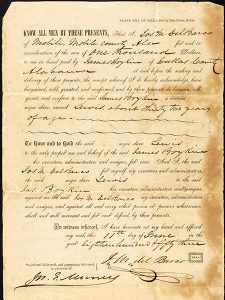
Includes bills of sale, rental agreements, and other financial transactions involving enslaved people.
From business or organizational papers
- Shelby Iron Company (MSS.1261)
- See General Financial: Payroll and Timebooks:
- Timebook Negro Overtime (Box 1261.003)
- Coal Mine Account Book (Box 1261.652, Folder 4)
- See Manufacturing Operations: Labor and Material Records:
- Labor Distribution Negro Time (Box 1261.652)
- See General Financial: Payroll and Timebooks:
- George W. Carmichael and Company bills (in Wade Hall Collection on Slavery in the United States, MSS.4250)
- Box 4250.001, Folder 5
- University of Alabama Administrative Records (RG.001)
- See Slave Labor (Box 19801776-003, Folders 90A-90D) (Digitized items)
From personal or family papers
- William A. Morris papers (MSS.1021)
- Box 3548, Folder 5
- Sarah G. Williams and M. Stanly papers (in Wade Hall Collection on Slavery in the United States, MSS.4250)
- Box 4250.001, Folder 14 (Digitized items)
- Jackson Napoleon Chadwick papers (MSS.4168)
- Box SC0110, Folder 4168.01
- King family papers (MSS.0817)
- See Accounts: Slave purchases (Box 2905, Folder 12)
- James Boykin papers (MSS.0196)
- See and Business records (Box 1518, Folder 6) (Digitized items)
- See Burwell Boykin: Misc. papers (Box 2910, Folder 6) (Digitized items)
- Joshua Hill Foster papers (MSS.0535)
- See Bills of sale for slaves (Box 412, Folder 5) (Digitized items)
- Robert Jemison Jr. papers (MSS.0753)
- See Business and Plantation Accounts: North East and South West Railroad Company: Receipts for Hire of Slaves, 1853-1859 (Box 0753.0054, Folder 06) (Digitized items)
- Henry De Lamar Clayton Sr. papers (MSS.0313)
- See Family and Personal Data: Legal and Financial: Slaves (Box 309, Folder 3) (Digitized items)
- John Cocke papers (MSS.0328)
- See Financial Papers: Receipts (Box 3458, Folders 9, 16, 22, 24, 25, 26) (Digitized items)
- Watkins Family Papers (MSS.1530)
- See James L. Watkins: Negro slaves (Box 4114, Folders 14-15)
- See Brackett O. Watkins: Business: Negro purchases (Box 4114, Folder 20)
- Daniel C. Smyly papers (MSS.1300)
- See Receipts: Slave bill of sale (Box 1551, Folder 2)
- See Family and others: Malena Smyly (Box 1551, Folder 17)
- William and Crawford L. Brown family papers (MSS.3759)
- See Bills of sale for slaves (Box 3759.001, Folder 6) (Digitized items)
Single receipts or bills of sale
- W. S. Adkins bill of sale (MSS.0012)
- Box 1
- George W. Oliver receipt (MSS.1080)
- Box 1111, Folder 11
- William Gary receipt (MSS.0563)
- Box 640
- Louisiana Boykin receipt (in Wade Hall Collection on Slavery in the United States, MSS.4250)
- Box 4250.001, Folder 22
- William Garrard and Samuel N. Luckett bill of sale (in Wade Hall Collection on Slavery in the United States, MSS.4250)
- Box 4250.001, Folder 4 (Digitized item)
- Carlet G. Richardson receipt (in Wade Hall Collection on Slavery in the United States, MSS.4250)
- Box 4250.001, Folder 12
- Mary Allen receipt (in Wade Hall Collection on Slavery in the United States, MSS.4250)
- Box 4250.001, Folder 18
- T. B. Greenley receipt (in Wade Hall Collection on Slavery in the United States, MSS.4250)
- Box 4250.001, Folder 21
- Jacob Ramser receipt (in Wade Hall Collection on Slavery in the United States, MSS.4250)
- Box 4250.001, Folder 17 (Digitized item)
- A. L. Armstrong receipt (in Wade Hall Collection on Slavery in the United States, MSS.4250)
- Box 4250.001, Folder 20
- J. H. Schraebel bill of sale (MSS.4020)
- Box SC0095, Folder 4020.01
Other single documents
- George Benagh promissory note (MSS.1603)
- Box 2826, Folder 1603.01
- John Davis mortgage (MSS.0406)
- Box 571
- Carriere and Borduzat conveyance (MSS.0282)
- Box 1451
- William Todd and John H. Bilks slave rental invoice (MSS.2213)
- Box SC0007, Folder 2213.01
- Samuel Steele letter (in Wade Hall Collection on Slavery in the United States, MSS.4250)
- Box 4250.001, Folder 9 (Digitized item)
- W. G. Hann letter (in Wade Hall Collection on Slavery in the United States, MSS.4250)
- Box 4250.001, Folder 13
- John McDowell Financial Statement (in Wade Hall Collection on Slavery in the United States, MSS.4250)
- Box 4250.001, Folder 25
3. Legal Documents
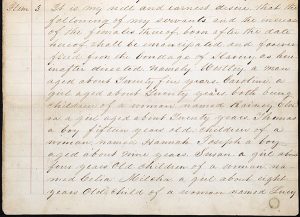
Includes wills as well as documents on legal proceedings related to slavery or enslaved people.
- Marvin P. Harper papers (MSS.0632)
- Box 2289
- W. L. Campbell deposition (in Wade Hall Collection on Slavery in the United States, MSS.4250)
- Box 4250.001, Folder 15 (Digitized item)
- William Waltrip and Franklin Wright Depositions (in Wade Hall Collection on Slavery in the United States, MSS.4250)
- Box 4250.001, Folder 16
- Matthew Crumb and Margaret Vest Legal Documents (in Wade Hall Collection on Slavery in the United States, MSS.4250)
- Box 4250.001, Folder 2
- Lewis L. Marks estate papers (MSS.2813)
- Box SC0042, Folder 2813.1
- Clements family papers (MSS.0316)
- See Hardy Clements: Will (Box 389, Folder 1)
- Robert B. McAfee Letter of Emancipation (in Wade Hall Collection on Slavery in the United States, MSS.4250)
- Box 4250.001, Folder 6
- William Law Legal Brief (in Wade Hall Collection on Slavery in the United States, MSS.4250)
- Box 4250.001, Folder 8 (Digitized item)
- Depositions of Lewis and Mary Ann Chandoin (in Wade Hall Collection on Slavery in the United States, MSS.4250)
- Box Wade-Hall-OS0001, Folder 4250.01
- William Richardson Last Will and Testament (in Wade Hall Collection on Slavery in the United States, MSS.4250)
- Box 4250.001, Folder 11
- Ellen McDowell Legal Document (in Wade Hall Collection on Slavery in the United States, MSS.4250)
- Box 4250.001, Folder 24
- Depositions of Peyton and Jane Graves in the Case of Elva v. Edwin Jenkins (MSS.4234)
- Box SC0108, Folder 4234.01
By Topic
4. Slavery and slave trade
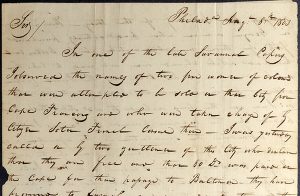
Includes items discussing slavery as an institution.
- Richard Dennis letter (in Wade Hall Collection on Slavery in the United States, MSS.4250)
- Box 4250.001, Folder 3 (Digitized item)
- Joseph Meek and C. Haynes letters to Samuel Logan (in Wade Hall Collection on Slavery in the United States, MSS.4250)
- Box Wade-Hall-OS0001, Folder 4250.02 (Digitized items)
- William S. Wright Letter (MSS.2210)
- Box SC0007
- Iveson L. Brookes papers (MSS.0214)
- See Correspondence (various boxes)
- See Diaries (Box 422)
- See Ms to “In Defence of the South” (Box 420, Folder 5)
- See Ms of Letters to Editors (Box 420, Folder 6)
- Woodward Family papers (MSS.1577)
- See S. H. Woodward: Miscellaneous (Box 2183, Folder 26) — essay “Statement, The Justice of Slavery Extension, 1848” (Digitized item)
5. Plantation system
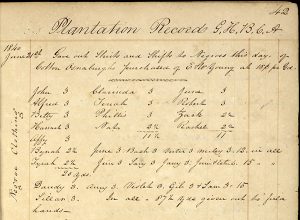
Information about the running of a plantation, including the work done by enslaved people and their care. See Financial Documents for bills of sale, rental receipts, and other transactions.
- C. T. Conn slave pass (in Wade Hall Collection on Slavery in the United States, MSS.4250)
- Box Wade-Hall-OS0001, Folder 4250.03
- Manly Family papers (MSS.0900)
- See Basil Manly Sr.:
- Correspondence (Box 292)
- Diaries (Boxes 393-394) (Digitized items)
- Digitized collection
- See Basil Manly Sr.:
- Robert Jemison Jr. papers (MSS.0753)
- See Correspondence:
- Business papers – Plantation proclamations (Box 0753.0008, Folder 01) (Digitized item)
- See Business and plantation accounts: Plantation accounts:
- Account book (Box 0753.0018, Folder 04) (Digitized item)
- Digitized collection
- See Correspondence:
- Hugh Davis papers (MSS.1611)
- See Farm operations: Farm journals (Box 3462, Folders 2-6) (Digitized items)
- Pocket diaries (Box 3462, Folder 8) (Digitized items)
- Slave receipts (Box 3462, Folder 9) (Digitized items)
- Digitized collection
- James Boykin papers (MSS.0196)
- See James Boykin: Medical expenses (Box 1518, Folder 3)
- Digitized collection
- John and Mary Wellborn Cochran Diaries, Letterbook, and Photographs (MSS.0326)
- See John Cochran Letterbook/journal (Box 805, Folder 2) (Digitized item)
- Jesse Beene letters (MSS.0128)
- See Letter 1839 (Box 15, Folder 13)
- John Horry Dent papers (MSS.0430)
- See Plantation book (Box 0430.0001, Folder 2) (Digitized item)
6. Antebellum race attitudes
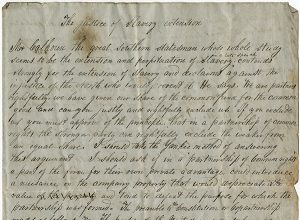
Includes expression of personal opinions on race and accounts of race relations.
- Archimedes Hank petition and letters (MSS.0619)
- Box 631
- Jacob Ackerly Letter (in Wade Hall Collection on Travel and Tourism, MSS.4248)
- Box SC0008, Folder 2118 (Digitized item)
- Charles R. Durkee Letter (in Wade Hall Collection on American Life, MSS.4257)
- Box 4257.004, Folder 11
- Uncle Tom’s Cabin Illustrated Pages (in Wade Hall Collection on Slavery in the United States, MSS.4250)
- Box 4250.001, Folder 27
7. Fugitive slaves
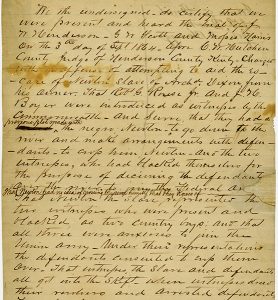
Includes expression of personal opinions on fugitive slave law and accounts of slave escape and capture.
- James S. Fruit, L. R. Burk, and John L. Blangy Deposition (in Wade Hall Collection on Slavery in the United States, MSS.4250)
- Box 4250.001, Folder 23 (Digitized item)
- Francis Taylor Letter (in Wade Hall Collection on American Life, MSS.4257)
- Box 4250.015, Folder 21
- J. W. Scott letter (in Wade Hall Collection on Slavery in the United States, MSS.4250)
- Box 4250.001, Folder 10 (Digitized item)
- Reward broadside for runaway slaves (MSS.3761)
- Box SC0096, Folder 3761.01
8. Free people of color
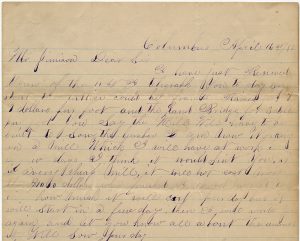
Includes materials related to the lives of free people of color, whether born free, manumitted, or emancipated. For discussion of emancipation as a phenomenon, see the section Emancipation below.
- Creole Social Club records (MSS.0374)
- Box 3602
- Digitized collection
- Patti Julia Malone autograph album and papers (MSS.4169)
- Box 4169.001, Folders 1-8
- Jere Haralson letter (MSS.0625)
- Box 631
- Joseph Daugherty Receipts (MSS.1686)
- Box 6476, Folder 43
- Samuel and Ruth M. Lowery Fundraising Appeal (MSS.1731)
- Box 6526, Folder 3
- D. Spreacher Letter (in Wade Hall Collection of Civil War Materials, MSS.4273)
- Box 4273.001, Folder 046 (Digitized item)
- Chauncey Leonard letter (MSS.4148)
- Box SC0107, Folder 4148.01
- Five certificates attesting to the service of African American sailors during the Civil War (MSS.4149)
- Box SC0107, Folder 4149.01
- Nearror family histories (MSS.4189)
- Box SC0114, Folder 4189.001-002
- Digitized collection
- S. D. Cabaniss Papers (MSS.0252)
- See Box 252.005, Folder 6 — W.D. Chadick report concerning the prospects for freed persons in Ohio, 1858 (Digitized item)
9. Emancipation
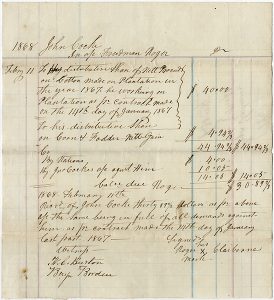
Includes information about and opinions on emancipation as well as the system set up for freedmen.
- Office Sup’t Bureau of Refugees, Freedmen, and Abandoned Lands broadside (MSS.4052)
- Box SC0100, Folder 4052.01
- Bureau of Refugees, Freedmen and Abandoned Lands labor contract (MSS.0230)
- Box 195
- Margaret Pearson Sharecropping Agreement (MSS.1706)
- Box 6476, Folder 63
- Bird Griffin papers (MSS.0596)
- See Freed slaves (Box 2644, Folder 13)
- John Cocke papers (MSS.0328)
- See Financial Papers: Accounts with Laborers: Pay Receipts (Box 3459, Folders 11-15) (Digitized items)
- See Legal Papers: Miscellaneous Legal Documents, 1827-1865 — Legal document between William Q. Smith, Commissioner of the District Court of the United States for the Middle District of Alabama, and John Cocke, Greene County Alabama, concerning the emancipation of slaves, August 19, 1865 (Box 3459, Folder 27) (Digitized item)
- Digitized collection
- Durst Family papers (MSS.0461)
- See Contracts 1 of 2 (Box 0461-0001, Folder 2) (Digitized items)
10. Post-war race attitudes
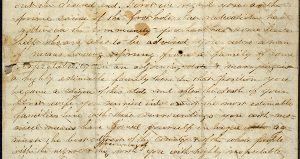
Includes expression of personal opinions on race and accounts of race relations.
- Ryland Randolph trial transcript (MSS.1179)
- Box 1451
- Citizens of Macon County Ku Klux Klan Letter (MSS.0303)
- Box 2960, Folder 1
- O. A. Luckett letters (in Wade Hall Collection of Civil War Materials, MSS.4273)
- Box 4273.001, Folder 039 (Digitized items)
- Dan Price letter (MSS.3713)
- Box SC0088, Folder 3713.01
- John Horry Dent papers (MSS.0430)
- See Farm journal (Box 0430.0001, Folder 4) (Digitized item)
- Henry De Lamar Clayton Sr. papers (MSS.0313)
- See Speeches (Charges to the Grand Jury), 1866 — Charge to Grand Jury, Judge H. D. Clayton, 1866 (Digitized item)